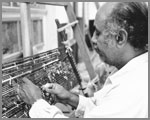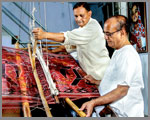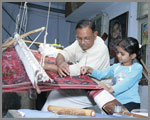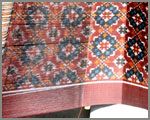

Creating design by tyeing knots on warp and weft
Warp and weft silk threads are tied separately with cotton thread on the portions already marked out in conformity with the proposed design in the fabric. This tied portion is meant to remain unexposed to the colour while dyeing. United portion which has absorbed one colour, may be tied while dyeing in another colour. Tyeing untying, retying and dyeing in different shades are the main features of this process.

Dyeing Process
After completion of dyeing work of warps & wefts, the threads of the warp of different repeats of a pattern are put together in a sequence on the loom, so that the design becomes visible. The threads of wefts are wound on to bobbins and kept in the bamboo shuttle for weaving process.

Traditional Patola Loom
The patola is woven on a primitive hand operated harness loom made out of rosewood and bamboo strips. The loom lies at a slant, with the left side being lower than the right side. The bamboo shuttle is made to move to and fro through warp shades. Each weft thread is thoroughly examined and matched with each part of the warp design pattern while weaving.

Adjusting The Design
The tension of the warp threads are removed by the help of needle after every time weaving of 8" to 10" of fabric. Patola weaving is a highly accurate just a positioning of warp and weft of similar colour to obtain perfect design and harmony.The process is labour intensive, time consuming and requires high order of skill and dexterity.

Traditional Patola
It takes three to four months to prepare tie- dyed design on warp and weft threads for one sari of 6 yards length by 48" width. Two Salvis (weavers) working together weave just about 8" to 9" a day. It takes 40 to 50 days to weave a sari. Thus 4 to 5 persons take a periods of 5 to 6 months to complete a sari depending on the intricacy of the design.
 Patan Potala
Patan Potala